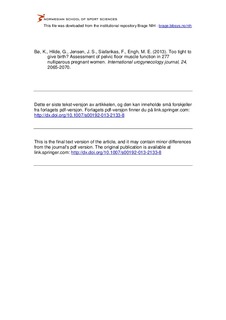| dc.contributor.author | Bø, Kari | |
| dc.contributor.author | Hilde, Gunvor | |
| dc.contributor.author | Jensen, Jette Stær | |
| dc.contributor.author | Siafarikas, Franziska | |
| dc.contributor.author | Engh, Marie Ellstrøm | |
| dc.date.accessioned | 2014-09-03T11:26:58Z | |
| dc.date.available | 2014-09-03T11:26:58Z | |
| dc.date.issued | 2013-06-08 | |
| dc.identifier.citation | International Urogynecology Journal. 2013, 24, 2065-2070 | nb_NO |
| dc.identifier.uri | http://hdl.handle.net/11250/218678 | |
| dc.description | I Brage finner du siste tekst-versjon av artikkelen, og den kan inneholde ubetydelige forskjeller fra forlagets pdf-versjon. Forlagets pdf-versjon finner du på link.springer.com: http://dx.doi.org/10.1007/s00192-013-2133-8 / In Brage you'll find the final text version of the article, and it may contain insignificant differences from the journal's pdf version. The definitive version is available at link.springer.com: http://dx.doi.org/10.1007/s00192-013-2133-8 | nb_NO |
| dc.description.abstract | Introduction and hypothesis: Theoretically, tight or strong pelvic floor muscles may impair the progress of labor and lead to instrumental deliveries. We aimed to investigate whether vaginal resting pressure, pelvic floor muscle strength, or endurance at midpregnancy affect delivery outcome.
Methods: This was a prospective cohort study of women giving birth at a university hospital. Vaginal resting pressure, pelvic floor muscle strength, and endurance in 300 nulliparous pregnant women were assessed at mean gestational week 20.8 (±1.4) using a high precision pressure transducer connected to a vaginal balloon. Delivery outcome measures [acute cesarean section, prolonged second stage of labor (> 2 h), instrumental vaginal delivery (vacuum and forceps), episiotomy, and third- and fourth-degree perineal tear) were retrieved from the hospital’s electronic birth records.
Results: Twenty-three women were lost to follow-up, mostly because they gave birth at another hospital. Women with prolonged second stage had significantly higher resting pressure than women with second stage less than 2 h; the mean difference was 4.4 cmH2O [95 % confidence interval (CI) 1.2–7.6], p < 0.01, adjusted odds ratio 1.049 (95 % CI 1.011–1.089, p = 0.012). Vaginal resting pressure did not affect other delivery outcomes. Pelvic floor muscle strength and endurance similarly were not associated with any delivery outcomes.
Conclusions: While midpregnancy vaginal resting pressure is associated with prolonged second stage of labor, neither vaginal resting pressure nor pelvic floor muscle strength or endurance are associated with operative delivery or perineal tears. Strong pelvic floor muscles are not disadvantageous for vaginal delivery. | nb_NO |
| dc.language.iso | eng | nb_NO |
| dc.publisher | Springer Verlag | nb_NO |
| dc.subject | delivery | nb_NO |
| dc.subject | endurance | nb_NO |
| dc.subject | pelvic floor | nb_NO |
| dc.subject | strength | nb_NO |
| dc.subject | second stage | nb_NO |
| dc.subject | vaginal resting pressure | nb_NO |
| dc.title | Too tight to give birth?: assessment of pelvic floor muscle function in 277 nulliparous pregnant women | nb_NO |
| dc.type | Journal article | nb_NO |
| dc.type | Peer reviewed | nb_NO |
| dc.subject.nsi | VDP::Medical disciplines: 700 | nb_NO |
| dc.source.journal | International Urogynecology Journal | nb_NO |
| dc.description.localcode | Seksjon for idrettsmedisinske fag / Department of Sports Medicine | nb_NO |
